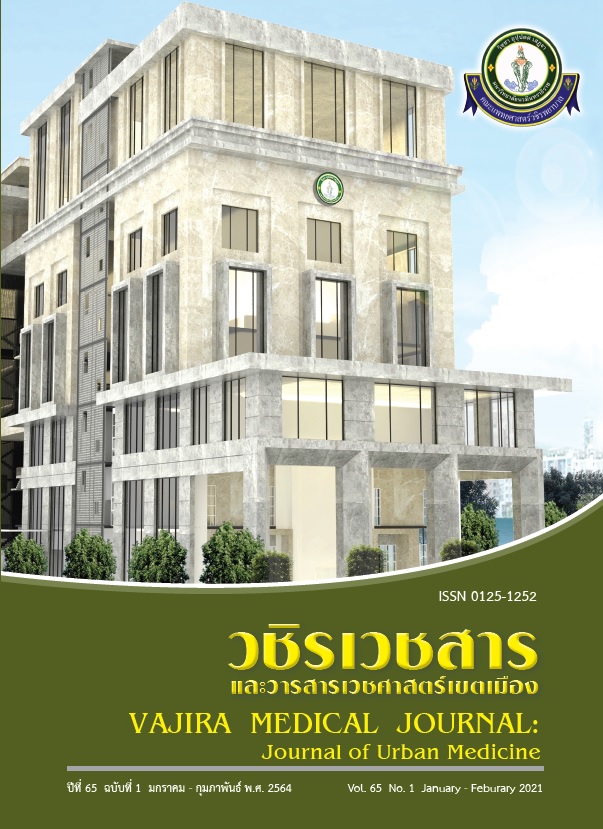Thai Scales for Outcomes in Parkinson’s Disease-Nighttime Sleep and Modified Parkinson’s Disease Sleep Scale for Assessment of Nighttime Sleep Disorder Compared with Pittsburgh Sleep Quality Index at the Faculty of Medicine Vajira Hospital
Main Article Content
Abstract
Objectives: This study aimed to evaluate the sensitivity and specificity of the Thai versions of Scales for Outcomes in Parkinson’s Disease-Nighttime Sleep (SCOPA-NS) and Modified Parkinson’s Disease Sleep Scale (MPDSS) test for patients with Parkinson’s disease in comparison with the Pittsburgh Sleep Quality Index (PSQI) test.
Methods: This cross-sectional study enrolled patients with Parkinson’s disease who sought treatment at the OPD department, Division of Neurology, Faculty of Medicine Vajira Hospital. The study was conducted from 1 March 2019 to 31 December 2019. Volunteers completed Thai SCOPA-NS and MPDSS sleep tests to obtain the sensitivity and specificity of each test, which was then compared with the PSQI test.
Results: Of the 216 volunteers, 200 met the study criteria. To evaluate nighttime sleep, SCOPA-NS test and MPDSS test in Thai language were used. The prevalence rates of sleep disorders in volunteers using the SCOPA-NS test and MPDSS test were 62.5% (95% confidence interval [CI] 55.4–69.2) and 52.5% (95% CI 45.3–59.6), respectively. Youden’s index (1− (sensitivity + specificity)) was used to find the optimal cut-off points by comparing it with the PSQI test. SCOPA-NS test has a sensitivity of 83.1% (95%CI 75.3–89.2), specificity of 71.1% (95% CI 59.5–80.9), positive predictive value (PPV) of 82.4% (95% CI 74.6–88.6), and negative predictive value (NPV) of 72% (95% CI 60.4–81.8), whereas the MPDSS test has a sensitivity of 71.8% (95% CI 63.0–79.5), specificity of 78.9% (95% CI 68.1 87.5), PPV of 84.8% (95% CI 76.4–91.0), and NPV of 63.2% (95% CI 52.6–72.8). The volunteers preferred doing the SCOPA-NS test than the MPDSS test with preference rates of 65.5% and 34.5%, respectively.
Conclusion: Thai SCOPA-NS test has higher sensitivity but lower specificity than the MPDSS test. However, patients significantly prefer doing the Thai SCOPA-NS test than the MPDSS test. Both tests can be used to evaluate patients with Parkinson’s disease at comparable accuracy. However, Thai SCOPA-NS test took shorter test, and patients with Parkinson’s disease prefer this test. We recommend using Thai SCOPA-NS in screening for sleep disorder in this patient population.
Downloads
Article Details
References
Kumar S, Bhatia M, Behari M. Sleep disorders in Parkinson's disease. Mov Disord 2002;17(4):775-81.
Martinez-Martin P, Schapira AH, Stocchi F, Sethi K, Odin P, MacPhee G, et al. Prevalence of nonmotor symptoms in Parkinson's disease in an international setting; study using nonmotor symptoms questionnaire in 545 patients. Mov Disord 2007;22(11):1623-9.
Tandberg E, Larsen JP, Karlsen K. A communitybased study of sleep disorders in patients with Parkinson's disease. Mov Disord 1998;13(6):895-9.
Witjas T, Kaphan E, Azulay JP, Blin O, Ceccaldi M, Pouget J, et al. Nonmotor fluctuations in Parkinson's disease: frequent and disabling. Neurology 2002;59(3):408-13.
Lolekha P, Kulkantrakorn K. Quality of life and sleep-related problems in patients with Parkinson's disease at Thammasat University Hospital. TMJ 2010;10(2):165-74.
Avidan A, Hays RD, Diaz N, Bordelon Y, Thompson AW, Vassar SD, et al. Associations of sleep disturbance symptoms with health-related quality of life in Parkinson's disease. J Neuropsychiatry Clin Neurosci 2013;25(4):319-26.
Duncan GW, Khoo TK, Yarnall AJ, O'Brien JT, Coleman SY, Brooks DJ, et al. Health-related quality of life in early Parkinson's disease: the impact of nonmotor symptoms. Mov Disord 2014;29(2):195-202.
Chaudhuri KR, Pal S, DiMarco A, Whately-Smith C, Bridgman K, Mathew R, et al. The Parkinson's disease sleep scale: a new instrument for assessing sleep and nocturnal disability in Parkinson's disease. J Neurol Neurosurg Psychiatry 2002;73(6):629-35.
Marinus J, Visser M, van Hilten JJ, Lammers GJ, Stiggelbout AM. Assessment of sleep and sleepiness in Parkinson disease. Sleep 2003;26(8):1049-54.
Buysse DJ, Hall ML, Strollo PJ, Kamarck TW, Owens J, Lee L, et al. Relationships between the Pittsburgh Sleep Quality Index (PSQI), Epworth Sleepiness Scale (ESS), and clinical/polysomnographic measures in a community sample. J Clin Sleep Med 2008;4(6):563-71.
Buysse DJ, Reynolds CF, 3rd, Monk TH, Berman SR, Kupfer DJ. The Pittsburgh Sleep Quality Index: a new instrument for psychiatric practice and research. Psychiatry Res 1989;28(2):193-213.
Sitasuwan T, Bussaratid S, Ruttanaumpawan P, Chotinaiwattarakul W. Reliability and validity of the Thai version of the Pittsburgh Sleep Quality Index. J Med Assoc Thai 2014;97 Suppl 3:S57-67.
Postuma RB, Berg D, Stern M, Poewe W, Olanow CW, Oertel W, et al. MDS clinical diagnostic criteria for Parkinson's disease. Mov Disord 2015;30(12):1591-601.
Goetz CG, Poewe W, Rascol O, Sampaio C, Stebbins GT, Counsell C, et al. Movement Disorder Society Task Force report on the Hoehn and Yahr staging scale: status and recommendations. Mov Disord 2004;19(9):1020-8.
Setthawatcharawanich S, Limapichat K, Sathirapanya P, Phabphal K. Validation of the Thai SCOPA-sleep scale for assessment of sleep and sleepiness in patients with Parkinson's disease. J Med Assoc Thai 2011;94(2):179-84.
Tanasanvimon S, Ayuthaya NI, Phanthumchinda K. Modified Parkinson's Disease Sleep Scale (MPDSS) in Thai Parkinson's disease patients. J Med Assoc Thai 2007;90(11):2277-83.
Hajian-Tilaki K. Receiver Operating Characteristic (ROC) Curve Analysis for Medical Diagnostic Test Evaluation. Caspian J Intern Med 2013;4(2):627-35.
Kumar R, Indrayan A. Receiver operating characteristic (ROC) curve for medical researchers. Indian Pediatr 2011;48(4):277-87.
Fluss R, Faraggi D, Reiser B. Estimation of the Youden Index and its associated cutoff point. Biom J 2005;47(4):458-72.
Habibzadeh F, Habibzadeh P, Yadollahie M. On determining the most appropriate test cut-off value: the case of tests with continuous results. Biochem Med (Zagreb) 2016;26(3):297-307.
Lolekha P, Kulkantrakorn K. Non-motor symptoms in Thai Parkinson’s disease patients:prevalence, manifestation and health related quality of life. Neurol Asia 2014;19(2):163-70.
Jongwanasiri S, Prayoonwiwat N, Pisarnpong A, Srivanitchapoom P, Chotinaiwattarakul W. Evaluation of sleep disorders in Parkinson's disease: a comparison between physician diagnosis and self-administered questionnaires. J Med Assoc Thai 2014;97 Suppl 3:S68-77.
Martinez-Martin P, Visser M, Rodriguez-Blazquez C, Marinus J, Chaudhuri KR, van Hilten JJ, et al. SCOPA-sleep and PDSS: two scales for assessment of sleep disorder in Parkinson's disease. Mov Disord 2008;23(12):1681-8.
Lin YY, Chen RS, Lu CS, Huang YZ, Weng YH, Yeh TH, et al. Sleep disturbances in Taiwanese patients with Parkinson's disease. Brain Behav.2017;7(10):e00806.


